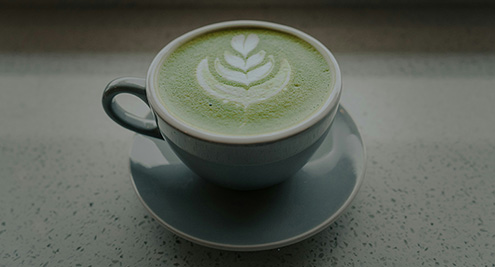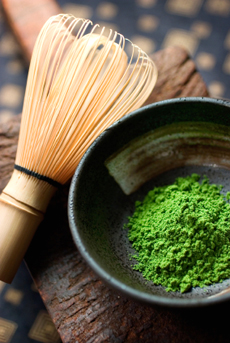Easiest Matcha Ice Cream Recipe & More Uses For Matcha Tea
|
Matcha green tea is used in the Japanese tea ceremony. The tender, shade-grown leaves, known as tencha, are stone-ground to a fine powder (here’s a kit to make your own). Whisked into a bowl of hot water, it produces a bright, grassy brew.
But Americans are more familiar with green tea ice cream, made with matcha tea, one of the finest Japanese teas. It’s not just delicious: It’s full of antioxidants. Matcha delivers much more of them: 1385 ORAC units per gram, compared to 253 for goji berries, 105 for pomegranate, 93 for wild blueberries and 60 for açaí (details). > The different types of tea: a photo glossary. > The year’s 23 tea holidays. > Below: much more to do with matcha. Here’s a super-easy recipe to make green tea ice cream at home, no ice cream maker required: 1. Soften a pint of high-quality vanilla ice cream until it is malleable. 2. Place the ice cream in a large mixing bowl. Stir in two tablespoons of matcha tea and blend well with a large spoon. 3. Cover the bowl with plastic wrap or refill the carton. 4. Return to the freezer and chill until set. |
 [1] Mmm: matcha ice cream (photo © Republic Of Tea).
|
|
|
MORE TO DO WITH MATCHA TEA |
||
 [3] To cut back on expense, matcha can be purchased in tins one-third this size (photo © Republic Of Tea). |
You can enjoy cup after cup of hot or iced matcha tea, or use it in these everyday foods: |
|
|
WHY IS MATCHA SO EXPENSIVE? Matcha tea is expensive, but worth it if you love the flavor of green tea. According to Matcha Source, Japanese tea, in general, tends to be more expensive than teas produced in other countries. It’s the rule of supply and demand: Japan is a small country (think of how much agricultural land there is in China and India, by comparison). The country only exports about one percent of its teas. Production is also more expensive. Only the youngest, sweetest leaves are used. Covering the fields with bamboo mats (tarps) to create the shade-grown tea weakens the tea plants, and a longer recovery period is needed before they can be harvested again. And at the factory, the stone grinders work slowly in order to maintain the nutrients in the tea, including the amino acid, L-theanine, which focuses the brain; it may help the body’s immune response to infection. Each grinder produces only about 40 grams of matcha in an hour. CHECK OUT WHAT’S HAPPENING ON OUR HOME PAGE, THENIBBLE.COM.
|
||




